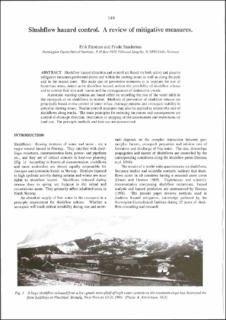| dc.contributor.author | Hestnes, Erik | |
| dc.contributor.author | Sandersen, Frode | |
| dc.contributor.editor | Hestnes, Erik | |
| dc.date.accessioned | 2023-08-04T11:36:16Z | |
| dc.date.available | 2023-08-04T11:36:16Z | |
| dc.date.issued | 1998 | |
| dc.identifier.isbn | 82-546-0184-4 | |
| dc.identifier.issn | 0078-1193 | |
| dc.identifier.uri | https://hdl.handle.net/11250/3082642 | |
| dc.description.abstract | Slushflow hazard detection and control are based on both active and passive mitigative measures performed above and within the starting zones as well as along the path and in the runout zone. The main aim of preventive measures is to regulate the use of hazardous areas, detect acute slushflow hazard, reduce the possibility of slushflow release and to restrict their size and runout and the consequences of destructive events. Automatic warning systems are based either on recording the rise of the water table in the snowpack or on slushflows in motion. Methods of prevention of slushflow release are principally based on the control of water influx, drainage patterns and snowpack stability in potential starting zones. Similar control measures may also be applied to restrict the size of slushflows along tracks. The main principles for reducing the runout and consequences are control of drainage direction, retardation or stopping of the snowmasses and restrictions on land-use. The principle methods and their use are summarised. | en_US |
| dc.language.iso | eng | en_US |
| dc.publisher | Norwegian Geotechnical Institute | en_US |
| dc.relation.ispartofseries | NGI Publication;203 | |
| dc.subject | Slushflow | en_US |
| dc.subject | Hazard | en_US |
| dc.subject | Avalanche-RnD | en_US |
| dc.subject | Snøskred-FoU | en_US |
| dc.title | Slushflow hazard control. A review of mitigative measures. | en_US |
| dc.type | Chapter | en_US |
| dc.source.pagenumber | 140-147 | en_US |
